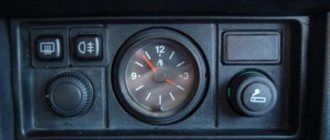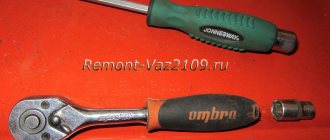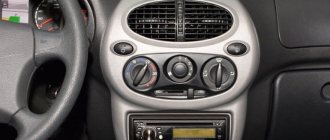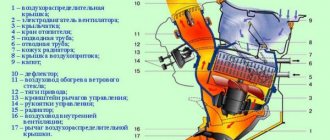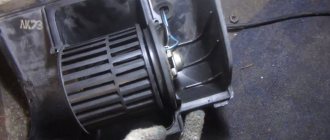Car owners of “nines” know the operating features of their car’s heating system. When everything is fine in summer, in winter the opposite situation occurs, and cold air enters the cabin. And this is already unpleasant, and also harmful to health. In addition, the side and windshields fog up. Problems with the VAZ-2109 stove must be resolved in advance in order to be fully equipped for winter.
The stable operation of the heating system in a car can be influenced by a huge number of factors. Therefore, before you begin troubleshooting, you need to generally understand how the system works.
The heater of VAZ 2108, 2109, 21099 does not heat, causes of malfunction
Using the example of the interior heater - the “stove” of VAZ 2108, 21081, 2103, 2109, 21091, 21093, 21099 cars, let’s look at the causes of a common malfunction: “the stove does not heat.” The solution to this problem will be relevant with the onset of the first cold weather.
Causes of malfunction - the stove does not heat
1. The car's engine cooling system is contaminated.
The heater radiator is a “stove” that is part of a small circle of the engine cooling system. Therefore, warm coolant (coolant) begins to flow into it, from the “jacket” around the cylinders, immediately after starting the engine. As a result, the “stove” should start heating almost immediately.
If there is air in the cooling system, it is driven into its highest point - the radiator, and the “stove” does not heat up and no coolant enters it. He rarely leaves there on his own. Therefore, it is necessary to force the air plug out.
2. Insufficient coolant temperature.
Reasons: the thermostat is faulty - the valve does not close, there is not enough coolant in the engine cooling system.
3. The heater radiator is clogged.
The blockage may be oxidation products of the cooling system or sealant, if it is repaired using it. Or after eliminating the leak using a special product. In this case, the coolant does not circulate through the radiator and it does not heat. It is necessary to remove it, wash it with a stream of water, and blow it with compressed air. If it is completely clogged, replace it with a new one.
4. The heater fan motor does not work.
In this case, warm air is not driven into the car interior. The motor may not operate fully or may not operate at any speed.
5. The heater control damper does not work.
The flow of warm air is not directed into the car interior.
6. The stove valve is stuck in the closed position.
In this case, coolant does not circulate through the radiator and it does not heat.
7. The partition inside the heater core fell out.
A partition is installed inside the radiator to prevent coolant from leaving it immediately. The delay allows the stove to work more efficiently. Without a partition, the stove will heat, but weakly.
The radiator can be checked for the presence of a baffle. We remove the radiator and direct a stream of water into one of its pipes. In a working radiator, the stream of water from the other pipe should come out with a delay. In a faulty one - immediately.
Notes and additions
— The warm-up time for the interior of a VAZ 2108, 2109, 21099 car at a temperature of about zero degrees (or with a slight minus) with a working heater - “stove” - is approximately five to ten minutes.
— A working “stove” 2108, 2109 should provide heating of the car interior at an air temperature of minus 20, at maximum speed, up to 20 degrees Celsius, and in the area of the driver’s and front passenger’s feet up to 25 degrees Celsius.
Troubleshooting methods
Methods for eliminating the problem of why the stove blows cold air at idle will depend on the reasons themselves, which have been rechecked in order. So, first of all, you need to check the coolant level in the expansion tank. Please note that this must be done on a cold engine (!!!), so that the coolant is also relatively cold and the car owner does not get burned.
If it is below the middle, then add coolant. In this case, it is necessary to take into account the compatibility of antifreeze. It is advisable to fill it with the same brand and class that is in the cooling system. If the antifreeze has not been changed for a long time and/or is in poor condition, then it is better to replace it with a new one.
If air pockets form in the cooling system, they must be removed. There are three main methods for removing air from the cooling line. They all boil down to allowing the engine to run with the system depressurized so that the air can come out of the system on its own during the antifreeze circulation process. You can perform the procedure for removing air from the cooling system yourself in the garage or even in the field.
When the check shows that the pump is faulty, it will have to be replaced accordingly. But to identify the problem, you will have to dismantle the water pump. Often the cause of failure lies in wear of the impeller, bearing, or depressurization of seals. As for the bearing and rubber seals, in some cases they are replaced with new elements.
If the reason lies in the difficulty of the passage of liquid through the heater radiator, then you can try to rinse it. At the same time, it will be possible to see if it has cracked the body, and, accordingly, if antifreeze is flowing through it and if air is being sucked in. Typically, flushing has a positive effect on the efficiency of the heater, including at idle speed of the engine, as well as when the car is driving on the highway or in the city driving cycle at high speeds.
If the car heater has a valve for supplying liquid to the radiator, then do not forget to check its operation. So, for example, on VAZs (both new and old), this is one of the weak points of the interior heating system.
When the stove heats poorly only when starting on a cold engine and the engine itself does not reach operating temperature for a long time, then the first thing you should do is check the operation of the thermostat. So, for the first few minutes, until the coolant reaches an operating temperature of about +80°C...+90°C, the pipe leading to the top of the main radiator will be cold and relatively soft. The thermostat valve should only open when the antifreeze is warm enough. If yours is different, the thermostat must be replaced. In rare cases, you can try to repair it, but it is better to install a new one.
The car's climate control system operates on the basis of its own separate software and hardware. Therefore, checking its operation depends on the specific brand of car and the type of system itself. The verification algorithm is usually described in the car manual. If such information is available, you can check it yourself. Otherwise, it is better to seek help from a car service center, preferably one that specializes in working with the specific brand of car being tested.
Why does the VAZ-2109 stove heat poorly and what to do
Car owners of “nines” know the operating features of their car’s heating system. When everything is fine in summer, in winter the opposite situation occurs, and cold air enters the cabin. And this is already unpleasant, and also harmful to health. In addition, the side and windshields fog up. Problems with the VAZ-2109 stove must be resolved in advance in order to be fully equipped for winter.
The stable operation of the heating system in a car can be influenced by a huge number of factors. Therefore, before you begin troubleshooting, you need to generally understand how the system works.
Faucet problems
In order to understand why a faucet may fail, you first need to understand its design. This element of the car includes only three main elements:
- frame;
- a damper rotating on an axis;
- handle.
Modern antifreezes contain a large number of different additives that improve their properties.
However, some additives have one significant drawback: they can precipitate. It is deposited exactly between the damper and the body, which will soon lead to a wedge. In this case, the reason is obvious: of course, cold air will come from the stove, because there will simply be no way to heat it.
If you notice that the faucet does not close completely, do not pull the handle too hard. This can lead to the fact that the damper's fastening to the axle simply breaks out. In this case, the tap will not close, but you will not get the optimal air temperature either. The malfunction is determined quite simply. Two hoses lead to the stove: the first supplies antifreeze to it, and the other performs the opposite function. The temperature of the liquid should be different. If it feels about the same to the touch, then that’s where the problem lies. Periodically, the tap needs to be removed and cleaned, then there will be no troubles.
Features of the heater on the VAZ-2109
The stove on a VAZ is an ordinary heat exchanger. The heating system is connected to the engine cooling system through a heater valve. When the stove starts, this unit opens and antifreeze enters the radiator of the heating system.
Coolant temperature under normal conditions ranges from 70 to 90 degrees.
As the antifreeze circulates through the radiator pipes, it cools, which leads to the release of heat.
An important component of the heating system on the “nine” is the fan, which operates in one of three modes. This element directs the heated air mass into the nozzles, and the driver regulates the flow distribution using deflectors. In exactly the same way, air enters the car windows.
When you move the heater control knobs, the damper closes completely and warm air does not enter the cabin, or when you set the handle to the extreme right position, all the air flows into the car through the channels.
In the middle position of the regulator, the air passes over the radiator and warms up, while the other part goes past.
Airiness of the heating system
If the heater is working properly, there are no leaks and the damper cable has been adjusted, but cool air is still coming out of the deflectors, then an air lock may have formed in the system. To get rid of it, put your car on a hill with its front wheels, open the tap all the way and turn on the gas.
Another consequence of weak and cold air from the nozzles may be a clogged radiator core. Most often, the radiator becomes clogged in the fall, since then the air through the fan into the radiator, in addition to dust, also includes fallen leaves, which get stuck in the radiator, and sometimes can fly into the cabin, since this VAZ model does not have a cabin filter.
Main stove malfunctions
As we have already mentioned, the stove is connected to the internal combustion engine cooling system. Accordingly, heating problems may arise for the following reasons:
- Insufficient amount of coolant in the system.
- Clogging of radiator tubes.
- There are air pockets in the system. To eliminate them, you will need to unscrew the cap of the radiator or expansion tank and let the engine idle for a while.
There are a number of cooling system malfunctions that can also affect the performance of the VAZ-2109 heating system. We look at the most common ones.
The weak point of the heating system is the valve through which antifreeze enters the heater radiator. This unit may leak. In this case, it must be replaced with a new one.
Poor quality coolant causes damage to rubber pipes due to its aggressive chemical composition.
Check the condition of the pump, which is responsible for pumping antifreeze and circulating it in the cooling system.
Poor operation of the stove can be caused by incorrect operation of the electric motor that drives the heating system fan.
If you notice extraneous sounds in the operation of this motor, this is a signal for a number of problems:
- Possible overheating due to fuse failure.
- When operating at low speeds, warm air does not flow - the electric motor has failed or there has been a break in the electrical circuit of the heating system.
Check the condition of the heater core regularly. It can become clogged during operation, and this provokes an insufficient supply of antifreeze. To carry out preventive work, you need to dismantle this element and wash it. If the part cannot be cleaned, then it is better to buy a new one and replace it.
Experienced car enthusiasts claim that the problem of poor operation of the stove may be a loose fit of the damper. Because of this, cold air from the street enters the cabin, and warm air goes to the feet. To solve this problem, just adjust the damper using a special control lever. It is located next to the gas pedal. Use pliers to tighten the cable that goes to the damper. Make two turns around the head of the bolt that secures the cable to the control arm.
If these steps do not help solve the problem, then inspect the joints of the pieces of foam rubber or plastic. Perhaps cracks and gaps have formed there. You can solve the problem with the help of sealant or simply change the insulation.
Diagnosing Heater Problems in a 2012 Jeep Wrangler (and Others)
The Jeep Wrangler has a heater actuator problem that is almost the same as the Jeep Liberty. This problem is described below and then we will talk about another known problem with sandy material clogging the system.
Drive fix
Unfortunately, the Jeep Wrangler doesn't have as much behind-the-dash access as the Jeep Liberty. But you can tell if you need to start disassembling your panel by simply looking behind it on the left side.
As with the Jeep Liberty, the air conditioning and heating system is the center dial on the dash. This opens and closes the damper behind the dash to determine how much hot or cold air is entering the system. This is controlled by an electronic part called an actuator. It simply goes up and down to open and close the damper.
What you need to do is look under the dash and find the white plastic piece that moves when you turn the dial. You may need a light to shine there and see it all clearly and clearly.
If you see the white plastic moving, then the problem is not the drive and your problem may be sand deposits, as described in the next section. But if you see the white plastic part and it doesn't move, then your drive has failed.
As I said, the layout of this drive is a little more complex than on the Jeep Liberty. There is a panel on the left side under the steering wheel that can be removed for more access. This may not be ideal access to it, but it will mean you can remove the drive without removing the entire panel.
Once the actuator is removed, you can open the damper manually by turning the gear to which the actuator is attached. Start the engine and after a few minutes, see if heat escapes into the cabin.
Prevention and care of the VAZ-2109 stove
To avoid problems with the stove in cold weather, it is recommended to periodically maintain the system. Use the following recommendations:
- Clean the radiator from internal contaminants that may accumulate during long-term use.
- Use only high quality coolant. You should not save on such consumables. Low quality products can clog the system or damage the rubber pipes. Accordingly, it is better to use a good antifreeze than to subsequently incur additional expenses on repairing the cooling or heating system.
- Check the thermostat's operation regularly. This device is designed to maintain a certain temperature in the system. If the unit jams, the liquid will not flow into the stove radiator, and the motor will begin to overheat.
- Pay attention to the condition of the fan bearing. From time to time it is recommended to lubricate this element.
To summarize, we note that in the absence of preventive maintenance during the operation of the car, in any case, problems with the heating system on the VAZ-2109 will someday “come out”. In the article we looked at how the stove on the “nine” works, as well as the main malfunctions and ways to solve them. If you were unable to identify the reason for the incorrect operation of the VAZ-2109 heating system, then we recommend contacting a service center. This approach will save you time and money.
Principle of operation
The heater consists of:
Essentially, it is a heat exchanger connected to the cooling system of the power plant via a heater tap. If you open it, hot coolant enters the radiator. There it cools, giving off heat to the metal plates and returning to the circuit.
The main unit that supplies heat to the cabin is a fan. The air blown through the radiator is heated there and supplied to the nozzles, by closing and opening which the driver and his passengers regulate the temperature and direction of the flow.
The VAZ 2109 stove does not heat well
Owners of domestic cars, including the VAZ-2109, are familiar with this problem: in the summer the stove heats very well, but in the winter cold air comes out of the deflectors. Driving in a cold cabin is not only not pleasant, but also harmful to the body, and besides, the stove does not do its main job - the flow of warm air does not blow through the windshield and side windows, which is why they constantly fog up.
There are many reasons why the stove on a VAZ 2109 does not heat, and to fix the problem, you need to know the principle of operation of the heater, its structure, as well as all possible breakdowns and causes of poor heating.
The principle of operation of the interior heater using the example of a VAZ-2109
Essentially, a heater stove is an ordinary heat exchanger. The heating system is connected to the engine cooling system through a heater tap. When you turn on the heater, the faucet opens and coolant flows into the heater radiator.
The coolant temperature is 70-90 degrees.
Passing through the radiator tubes, the liquid is cooled and this process is accompanied by the release of heat.
An important element of the VAZ-2109 stove is the fan, which can operate in three modes. The fan directs heated air into the nozzles, and the driver and passengers can adjust the direction of the flow using handles in the deflector. Air is also supplied to the windshield and side windows.
When the driver moves the heater control handles on the instrument panel, he either completely closes the damper and the supply of warm air stops, or moves the handle to the extreme right position and all the heated air enters the cabin through the tubes. If the middle position is selected, then part of the air flow passes over the radiator and heats up, and part simply passes by.
Main causes of breakdowns
Since the heater is connected to the engine cooling system, the design of which we previously wrote about on our car portal Vodi.su, heating problems may be associated with:
- with a low level of antifreeze or antifreeze;
- with clogged cooling radiator tubes;
- with air pockets in the ODS - you need to unscrew the radiator or tank cap and let the engine run for a while at low speeds.
Any other failures of the ODS also affect the operation of the interior heater stove.
The weak point is also the heater tap , through which antifreeze enters the heater radiator. The faucet may leak, so it is advisable to replace it with a new one. Due to poor quality antifreeze, cracks may appear in rubber tubes over time.
In addition, you need to monitor the condition of the coolant pump, which is responsible for circulating antifreeze in the system.
Also, the cause of heating problems should be sought in the electric motor that drives the stove fan. If you hear unusual sounds when the electric motor is running, this may indicate problems. The electric motor may overheat due to failed fuses. If warm air does not come from the stove at low speeds, then the problem is most likely with the electric motor or with the electrical circuit of the VAZ-2109 stove.
It is very important to monitor the condition of the heater core. It also clogs over time, which is why the liquid does not flow in full. It’s easy enough to remove the radiator and wash it; in extreme cases, you can buy a new one - it’s not too expensive and is available in almost any store.
Another very common problem is a loose damper . Because of this problem, cold air from the street can enter the cabin, but warm air blows over the driver's and passengers' feet.
Solving this problem is quite simple - you need to adjust the correct position of the damper using the damper control lever. This lever is located next to the gas pedal. You'll need to use pliers to tighten the cable that goes to the damper - just make two turns around the head of the bolt that secures the cable to the control lever.
If this does not help, then this means that gaps and cracks have formed between the joints of pieces of foam rubber or in the plastic. You can either seal them with sealant or replace the old insulation with a new one.
Tips for caring for the heating system of the VAZ-2109
To prevent the inside of your car from getting colder when the cold weather sets in, follow these simple tips.
Firstly, it is necessary to clean the heater radiator from internal contaminants that accumulate over time.
Secondly, fill the cooling system only with high-quality antifreeze and only the one recommended by the manufacturer. Do not forget that due to poor-quality antifreeze, growths form inside the radiator.
Third, check to see if the thermostat is functioning properly. This device is used to maintain a constant temperature in the system. If it starts to jam, the liquid stops flowing to the heater radiator, and the engine itself begins to overheat.
Periodically you need to monitor the condition of the fan bearing; it needs to be lubricated with oil from time to time. If you cannot determine the reasons on your own, you need to contact specialists at a car service center.
Why does the heater blow cold at idle?
The essence of the reason why a cold heater at idle in most cases comes down to problems with the engine cooling system. So, there are FIVE main reasons for this situation and several less common ones:
- Insufficient coolant level in the system . This is the most common and easiest option to fix. In such a situation, even significantly heated coolant is not able to sufficiently warm up the interior heater. Please note that a low level of antifreeze in the engine cooling system not only causes the heater to blow cold air at idle, but also harms the engine itself, as overheating occurs, which leads to a decrease in its overall life. This problem is an indicator of the failure of its individual parts, or a change in their geometry.
- Formation of air jams . Air in the cooling system may appear due to depressurization of individual pipes or their connection points, improper replacement of coolant, malfunction of the air valve, problems with the pump, or a breakdown of the cylinder head gasket. Air locks impede the circulation of antifreeze in the system; as a result, the stove heats only when moving, and at idle cold air blows from the deflectors.
- Faulty water pump . This unit is responsible for circulating fluid through the system and when the impeller is not able to create sufficient flow, the heater blows cold air at idle, and when the car is moving it can be a little warmer.
- Dirty heater radiator . The heater radiator tends to become clogged over time. As a result, heated liquid begins to pass through its honeycomb poorly. And this, in turn, will lead to the fact that the stove fan drives barely warm, or even completely cold, air.
- The coolant supply is cut off . If the stove has a valve for supplying fluid to the heater radiator, then it may be that the car owner simply forgot to open it, having closed it in the summer, or it is jammed in a half-open or completely closed state. This is especially true for domestic cars, especially quite old ones (for example, VAZ “classic”, Moskvich and other cars of Soviet design). Typically, taps simply rust, especially when, instead of factory-made antifreeze, the car owner uses ordinary water as a coolant, especially “hard” water, that is, which contains a significant amount of salts of various metals.
- Thermostat failure . When the thermostat rod sticks in the open state, this will be the reason why the heater blows cold at idle. If in a cold engine the coolant initially circulates in a large circle, it will only be able to warm up after the car has been driving for a long time, or it will take a lot of time to warm up when the engine is idling.
- Problems with the operation of the climate control system . Modern cars equipped with this system sometimes experience software malfunctions, which leads to a situation where the heater does not heat up at idle. Problems may be associated with either incorrect configuration of a particular system, or a software or hardware failure of the climate control.
Cold air in the VAZ 2109 stove
At the same time, air in the VAZ 2109 stove can bring both benefit and harm. It all depends on compliance with the rules of vehicle operation, as well as the conditions in which it is carried out. In any case, if the VAZ 2109 stoves are out of order, this is not a reason to immediately contact professional auto mechanics. It is quite possible to study the structure of the VAZ stove yourself and try to fix the problem. If this event is not successful, then you can contact a specialist, for whom repairing a VAZ stove is an ordinary and rather mundane procedure.
The tap is not fully open
To check this, whether for this reason, it is enough to compare the temperature of the inlet and outlet pipes of the heater radiator; if it is different, then there is a high probability that the valve is not completely closed.
This problem can be solved by tightening the valve control cable and bringing the control lever to the maximum open position. But there is a danger that after these actions the valve will not close completely and it will be very hot in the cabin.
In addition, the valve has a big drawback - it is “designed” for a certain number of openings and closings. Where the axis of the control lever and the damper inside the valve connect, the tightness is lost and a leak forms over time. A solution may be to set the lever to the “hot-cold” position without further adjustment.
Usually, when you try to move the valve of the heater stove, a leak occurs, in this case, wrap the leak area with a strip of fabric soaked in sealant and fix it all with “cold welding”.
What needs to be fixed?
The design and diagram of the VAZ 2109 stove are quite expected for this model and have many similarities with previous releases.
Ventilation of the VAZ 2109 interior is supply and exhaust, carried out through special holes in the windshield linings. In this case, the air easily escapes outside, but when it gets inside, it is retained using a special lining. Thanks to this, it is possible to significantly improve the thermal insulation in the cabin.
The design of the VAZ 2109 stove is quite simple and includes:
- Electric fan . It consists of an impeller capable of 3 types of speeds, and is attached to the surface of the VAZ heater with just a few screws. Additional resistors installed on the left side in the hole in the stove casing can provide the required rotation speed.
- Stove faucet . Includes the body itself, a plate valve and several pipes. In order to connect it to the heating system, special rubber hoses are used. Thanks to the plate valve, it is possible to control air heating. And a special regulator can help in this matter.
- Pump . The main task of this device is to facilitate the circulation of liquid through the radiator.
- Dampers and tap . Air is supplied to the open space, and then the heated liquid is passed there. In order for the process to begin, the dampers must be moved to the right all the way. Otherwise, the process will not be carried out.
Figure 1. Construction of a car heater.
As a rule, air for passengers of the VAZ 2108-2109 is supplied through nozzles: central, right and left. They are protected from uncontrolled air ingress by a damper with a special polyurethane foam seal. In addition, VAZ 2108-2109 drivers can adjust the flow rate: just open or close the damper more tightly. If you wish, you can change the direction of air movement.
The design of the VAZ stove allows the system to provide control conditions for passengers and the driver even at an air temperature of -20°C:
- +25°С - in the area of the feet of each person present;
- +20°С - directly inside the VAZ 2109 car.
Thus, traveling in the domestic VAZ 21099 becomes possible at any time and in any weather.
Poor damper operation
The damper has two extreme positions: “the radiator core is closed” and “the cold air supply hole is closed.” It’s easy to guess that in the first case, unheated air will enter the cabin, and in the second, heated air. The damper is rotated using a special cable, but over time it stretches. After some time, it will increase so much that it will not be able to fully do its job. In this case, the valve will not be completely closed. If it remains in the middle position, then both holes will be open at once, and the inside of your car will be cold. There is only one solution to the problem - adjusting the length of the cable. And this needs to be done regularly (at certain intervals).
What can break?
The problem that the VAZ 2109 stove does not heat well is by no means new and occurs in every third driver. We need to find out what exactly happened inside the VAZ 2109 stove:
- The fuse has blown. Eliminated by replacing the failed part.
- Damage to wires. At the initial stage, it is necessary to check how efficient the heating system is and, if necessary, eliminate the break or clean the charred contacts with a special tool.
- The fan of the VAZ stove does not work. Eliminated by replacing the failed component. Of course, a low panel will somewhat complicate the process of removing this element for an inexperienced driver, while a high panel, on the contrary, will open up an additional field for activity.
- Open circuit resistor. It is necessary to check the serviceability of the components, and then find out where exactly the break occurred. This issue is best dealt with by a professional electrician, while a non-specialist can look for a problem for a very long time. Even a stove diagram that literally breaks the system down into components won’t help.
- The heating switch has failed. The most common cause is burnt contacts or direct sticking of the pusher. In some cases, it can be eliminated only after the switch is replaced.
Another classic and no less common reason that the heater in a car does not heat is a malfunction of the radiator. The easiest way is to clean it, which gives a positive result in the vast majority of cases. Of course, in order to get to the radiator, it will be necessary to remove the dashboard and the heater housing, but all these manipulations will take no more than an hour.
After the radiator is removed and cleaned, you can put it back in place and check how the heating system now functions, whether the problems that caused the work have been resolved.
If the stove still blows cold air, the radiator will definitely have to be replaced.
The simplest solution
If the heater blows cold, the simplest thing you can do is tighten the cable that controls the heater damper. To do this, wrap it a couple of times around the damper control lever. It is located on the heater housing near the gas pedal.
Each joint of the air duct and the edge of the heater damper are covered with foam rubber, which is quite problematic for the control lever to compress completely. Therefore, during compression, a small gap remains and the damper, which directs air flows from the street directly or through it, cannot close completely. It closes in its upper position, while air flows into the front nozzles through the heater radiator, and into the upper and side nozzles from the street through the remaining gap. When the heater fan is running, and the car is still moving, a small gap is enough to keep the cabin cold.
To make it clearer what we're talking about, shorten the damper lever on the driver's side with your hand while the heater fan is running. After which you can notice how the sound changes and over time the temperature of the air flow coming from the deflector increases.
Unfortunately, this is not the only reason why cold air is blowing from the heater. Below are a few more reasons and options for solving them.
The VAZ 2109 high panel stove does not heat
The cold weather has arrived, and most owners of the VAZ 2109 are once again faced with a problem: from the nozzles of the heater pipes at the operating temperature of the coolant (about 90 degrees), barely warm, and often completely cold air is blowing into the cabin; in short, the heater does not heat well. In this state of affairs, in severe frost, even frosty side windows in the cabin “do not come off.”
The simplest solution to this problem is as follows. It is necessary to tighten the heater damper control cable. To do this, you can make one or two turns of this cable on the damper control lever. This lever is located on the body of the VAZ 2109 stove, next to the gas pedal (see photo).
Location of the VAZ 2109 heater damper lever
All the joints of the air ducts and the edges of the stove damper are covered with foam rubber, which is difficult to fully compress using the damper control lever. This leaves a gap of several millimeters. In this case, the damper directing the flow of air either from the street directly or through the heater radiator does not close completely. It closes “up”, while air flows into the front nozzles through the heater radiator, and into the top and side nozzles from the street, through those same millimeters. When the heater fan is running, and the car is moving, these millimeters are quite enough.
You can even get to this damper lever on the driver's side and try to tighten this lever with your hand while the heater fan is on. In this case, the left ear will be in the area of the air duct nozzle, and you can hear how the sound and temperature of the air leaving the nozzle changes.
Also, the reasons discussed below may be the reason for the ineffective operation of the Samara interior heating system.
Incomplete opening of the heater tap
This problem occurs in most front-wheel drive VAZ cars. You can check this by comparing the temperature of the inlet and outlet pipes of the heater radiator; if it is different, most likely the valve is not fully open. The solution is to tighten the control cable for this valve and adjust the valve control lever to the maximum open position. In this case, it is possible that now the valve will not close completely, but as they say, the heat does not break the bones. But here lies another problem.
It is known that this valve in Samar is a weak point, and after a certain number of “open-close” operations, the valve at the location of the axis connecting the control lever and the valve itself inside the valve loses its tightness and begins to leak. Some owners simply set the “heat-cold” lever to a certain position and leave it out of harm’s way. In this case, attempting to move the heater tap valve will most likely cause it to leak. If this happens, you can wrap a strip of fabric soaked in sealant around the leak site and fix it all with “cold welding”; this can also be done in the field if the necessary materials are available.
Location of the Lada Samara stove valve leak
A radical solution to the problem with a leaking heater tap on the VAZ 2109 would be to completely remove it from the system, or install a water supply ball valve. True, in the first case, the ability to adjust the volume of coolant entering the heater radiator is lost, and in the second case, this adjustment can only be made by looking under the hood. But, having got rid of a obviously unreliable unit, we get rid of possible problems in the future, and the remaining adjustment of the temperature of the air entering the cabin by the damper is enough for the eyes. By the way, in the “tens” the manufacturer removed this ill-fated valve.
Air duct leaks
The air forced by the stove fan partially goes into the cracks in the air paths, while the air flow weakens and cools. The solution would be to seal and seal all connections along the air path from the stove to the outlet nozzles. True, this operation is very labor-intensive, since you will have to disassemble the entire front panel, but the result will be a noticeable increase in air flow from the heating system deflectors.
Leaky ducts
Another factor in the formation of a cold flow instead of a hot one may be its loss in the cracks along the path from the fan, because of this the warm flow becomes weaker and cools down. To get out of this situation, you need to seal and glue all connections along the air flow path from the heater to the output nozzles. To do this, you will have to disassemble the dashboard, which in itself is long and laborious. But as a result, you will feel that the air flows from the heating system deflectors have increased.




